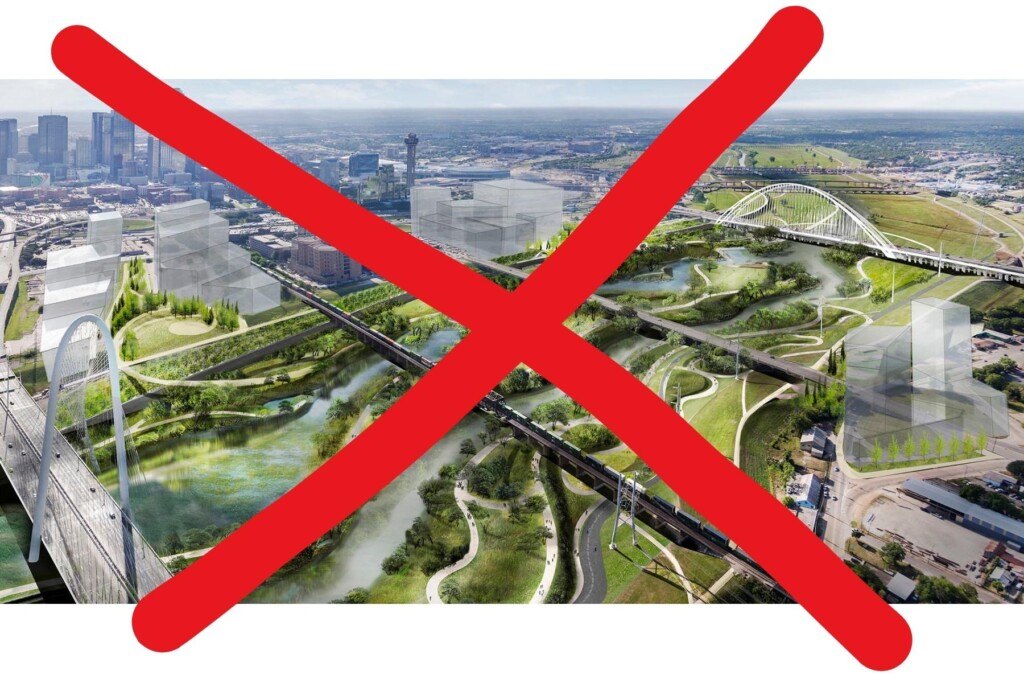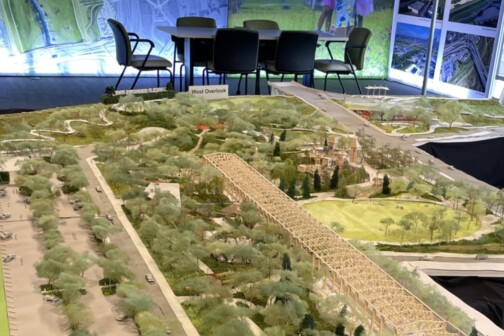This is exhausting. If you’re new to town, it would take me about 7,000 words to explain the history of the park we were supposedly going to build along the Trinity River, between the levees. Here’s the short version:
We straightened and moved the river in the early 1900s. Then, in 1998, we approved a $246 million bond program to do all sorts of things between the levees: run a tollroad through there, build a huge park with lakes that had solar-powered water taxis, and hire jugglers to work under overpasses. Then, in 2007, we had a referendum on the whole deal, and we voted to stay the course—except the tollroad became a parkway. Then, in 2016, Annette Simmons said, “You want $50 million?” And Mayor Mike Rawlings was like, “Hell, yes! We can build a great park down in that floodway. Hire some fancy architects!” In 2017, we officially killed the tollroad-parkway. Then, in 2018, Michael Van Valkenburgh Architecture unveiled the drawing you see at the top of this post, a plan for a 200-acre park between the levees.
Except now, not so much. The Trinity Park Conservancy, the group charged with leading the effort to build the Harold Simmons Park, has decided to leave the river alone. The plans for the park have shifted to outside the levees.
“The specific plan of putting the park proper in the levees, in terms of brick and mortar, has changed,” said Tony Moore, CEO of the Trinity Park Conservancy. “And, quite frankly, that changed just because the flooding cycles, with the sand and the silt and the debris that gets washed down, will just really make that design problematic.”
This is a huge shift. When Moore took the job, in 2021, I did a Q&A with him. Let’s revisit part of it:
TIM ROGERS: “We’ve seen renderings that Van Valkenburgh has produced for the Simmons Park. I look at those things, and, knowing that the Army Corps’ first mission is don’t let people die, which means don’t ever slow the water flow between the levees, all these renderings look to me like they’re impractical. And every time that objection has been raised by media or whoever, we’ve been told, ‘Well, it’s an iterative process.’ That word gets used a lot. It’s an iterative process. As in, what you see is not going to be the final product. Are you prepared to have the iterations that we’ve seen so far be tossed out?”
TONY MOORE: “You bring up an interesting point and a valid point. You’re building a park on a potential floodplain, right? And so understanding the dynamics and getting the counsel from the Army Corps from a safety point of view. We’re not going to do anything that’s not safe. So I think we’ll get to a happy medium. I’m anxious to learn and to better understand, and I don’t want to speak out of turn and ignorantly represent it. But I have confidence in Michael Van Valkenburgh. They’ve done parks on waterways and rivers before, so they have some knowledge going in there, some expertise. And obviously the Army Corps are the best. They know what they’re doing.
Now we jump forward a little more than two years, and Moore’s tune sounds different. “Between the levees and the floodway is still a very important part of the park,” he said. “It’s actually our largest geography. We’re just going to adjust what goes in there. The brick and the mortar and the park proper, we’ll put those outside the levees, attached to the levees but not down in the floodway.”
It’s such a huge shift that I found myself repeatedly asking Moore a version of the same question: “So wait. No park between the levees? Is that really what we’re talking about?” I called him because I’d heard rumblings about this shift.
Moore said, “I spent some time down there, and there’s just so much we can do from a nature point of view and embracing the river with 5K runs, 10K runs. We’re still using the floodway as we’re in nature, to unite to Dallas and bring east and west together. But, yes, the brick and mortar and all the park buildings and amenities—those will be just outside the levees now. So that’s a change, and I think it’s the better change. Since I’ve been here in Dallas, just a little over two years, I’ve seen a couple of those flooding cycles, and, man, the sand and the silt and all the debris and the logs get washed through. It would be problematic if we were to have all that brick and mortar down there.”
As I told Moore, this has been pretty obvious to a lot of people for a lot of years. The river is an inconsequential trickle—until it’s not. It’s wild to me that Van Valkenburgh even dared to draw those renderings. I guess the best color for expensive drawings really is green.
That’s all I can report for now. I’ll be headed over to the Trinity Park Conservancy in the coming days to get more details. Moore told me they had planned to go public next year with this news and with an update on their fundraising efforts.
The dream lives on.
Update (4:02) This blows my mind. Ken Kalthoff at NBC 5 had the “not between the levees” story way back in June. So fair play to him. But I don’t understand how this news dropped so quietly. Or why Tony Moore at the Trinity Conservancy didn’t say to me, “You know, Rogers, Big Ken beat you to this story by about three months.” Anyway, at least I didn’t make up quotes. This story might not quite be a breaking story, but it won’t need to be retracted. I can be thankful for that much.
Author







